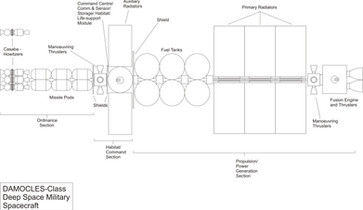HOME | DD
 improbableSpace — Interstellar Colony Ship
improbableSpace — Interstellar Colony Ship

Published: 2017-03-17 01:26:36 +0000 UTC; Views: 1848; Favourites: 18; Downloads: 19
Redirect to original
Description
“In the early days of interstellar spaceflight, humanity was faced with a dilemma: we wanted to colonize the stars, but the equipment necessary to keep humans alive for long stretches of time was too heavy to feasibly accelerate to near lightspeed. As such, sending live humans to even the nearest stars would take millennia. Robotic probes had been to these places, but how does an unmanned spacecraft colonize a world?
“That dilemma was swiftly solved. An unmanned spacecraft CAN colonize the stars, as we realized. Unmanned, in the sense that there aren’t any living humans onboard. Research into artificial intelligence had developed a way to reproduce the consciousness of any given person onto a computer, by way of self-improving learning algorithms and an MRI scan of the person’s brain structure. These digital simulations acted more or less exactly like regular humans – they had emotions, aspirations, and desires – and were treated as such. Yet they did not need food, water, air, and they could adjust themselves to long stretches of time, making them the perfect space travelers.
“The first interstellar colony vessels were the size of a 20th century submarine, and weighed about as much. Within their supercomputers existed the crew – copies of trained astronauts and scientists – as well as the code for several kinds of DNA. The ships themselves used antimatter-catalyzed nuclear fusion to accelerate to 20 percent lightspeed (0.2c); a steady stream of antiprotons is sprayed through hydrogen gas, causing it to explode and for the hydrogen nuclei to fuse. This of course creates a titanic amount of waste heat, so it must be gotten rid of with four vast heat radiators.
“Each ship took decades to reach its destination. Once in the target solar system, the vessel would detach one of its two atmospheric shuttles. The shuttle (also a spaceplane) would find a decently sized asteroid, and tow it into synchronous orbit around the soon-to-be-colonized planet. Then, using self-replicating nanomachines, would begin converting the asteroid into a space habitat. The other shuttle lands on the planet, and (also using nanomachines) would begin to create the actual surface colony. The two installations are then connected as the first shuttle tows a carbon-nanotube cable, hundreds of kilometers long, from the space habitat to the surface colony, creating a space elevator.
“Then, the nanomachines that built the surface colony switch gears. First, they construct artificial bodies for the digital crew (who have been orchestrating the whole construction process). Next, they use the DNA instructions from the ship’s supercomputer to engineer the colonists: zygotes, created molecule by molecule from the very elements mined from the planet. They grow in artificial wombs and, once born, are cared for by the crew. After a few generations pass, the planet becomes a fully-fledged colony.
“This entire process of interstellar colonization, despite been advanced during its time, was not without the occasional mishap. Some ships never made it to their destination, possibly engine failure during transit, or a particularly large rock destroying the dust impact shield. Sometimes, technology would malfunction, resulting in a colony that was half-built, or not built at all, or a significant portion of the planet was accidentally converted into machinery due to runaway nanomachines. And sometimes a successful colony might lose contact with Earth for whatever reason. But, most of the time, these early colonization efforts bore fruit – and resulted in some of the most powerful and influential worlds in Human Space.”
From ENCYCLOPAEDIA GALACTICA, excerpt by Forven Geisler
Related content
Comments: 5

👍: 0 ⏩: 0

👍: 0 ⏩: 0

Were you inspired by the "Von Braun" spacecraft from the speculative documentary "Alien Planet"?
👍: 0 ⏩: 2

haha I was about to comment the same thing
👍: 0 ⏩: 0

Yes I was! I like the overall look of the ship, and incorporated some of its more realistic parts into my ship (like the dust shield and the shuttles).
👍: 0 ⏩: 0

























